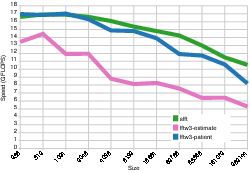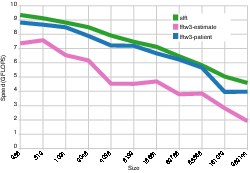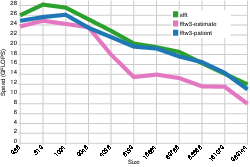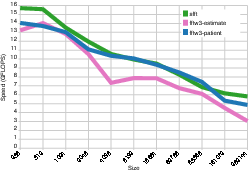| << Chapter < Page | Chapter >> Page > |




[link] shows the results of a benchmark for transforms of size 256 through to 262,144 running on a Macbook Air 4,2. The speed of FFTW 3.3 running in estimate and patient modes is also shown for comparison.
For each size of transform, precision and vector length (i.e., either SSE or AVX), several configurations of hard-coded leaf FFT were generated: three configurations of leaf size (16, 32 and 64), and if the transform was larger than 32,768, an additional transform with size-16 leaves and streaming store instructions was also generated. Before running the benchmark, the library was calibrated and the fastest configuration selected (details of the calibration are described in "Calibration" ).
For most sizes of transform, precision and vector length, SFFT is faster than FFTW running in patient mode. For the transforms with memory requirements that are approximately at the limits of the cache, FFTW running in patient mode is sometimes marginally faster than SFFT. Once the transforms exceed the size of the cache, SFFT is again the fastest.
It is important to note that FFTW running in patient mode evaluates a huge configuration space of parameters (and thus takes a long time to calibrate), while SFFT has, in this case, only evaluated either three or four configurations per transform.
SFFT is not itself an FFT library; the name refers to the elaboration program that reads a configuration file and generates the code for an FFT library. The code for the FFT library is then built as any other library would be.
As well as the generated code, there is infrastructure code which is common to all libraries generated by SFFT. This can be broadly categorized into three parts: initialization, dispatch and calibration.
Before an application can compute an FFT with SFFT, it must initialize a plan for the specific size, precision and direction of FFT. The library may have several FFTs and configurations that can compute the requested FFT, and it chooses the fastest option by timing each of the candidate configurations, which is at most 8 for any size of transform – a very small space compared to FFTW's exhaustive search of all possible FFT algorithms and configurations. Results and discussion describes an alternative to calibration, where machine learning is used with data collected from benchmarks to build a model that predicts performance.
After determining which implementation and parameters will be used, the initialization code allocates memory and populates any lookup tables that may be required. Before returning the plan to the application, a function pointer in the plan is updated to point to the FFT that has just been initialized.
Applications do not invoke any of the FFTs within SFFT directly. Rather they invoke a dispatch function on an initialized plan, which in turn transfers control to the correct FFT code within SFFT. The use of a dispatch function is purely a matter of convenience, so that users only need to deal with a few simple functions.
SFFT contains calibration code to measure the performance of the possible configurations of FFT on the target machine, which is at most 8 for each size of transform. Following calibration, the timing data is written to a file, which is then used by SFFT to select the fastest possible FFT for a given problem running on that machine.
SFFT is used much like other FFT libraries:
The plan is initialized for a given size, precision and direction of transform, and may then be executed any number of times on any data. Any number of plans can be simultaneously created and used.
int n = 1024;
double complex __attribute__ ((aligned(32))) *input, *output; input = _mm_malloc(n * sizeof(double complex), 32);
output = _mm_malloc(n * sizeof(double complex), 32);
for(i=0;i<n;i++) input[i] = i;
sfft_plan_t *p = sfft_init(i, SFFT_FORWARD|SFFT_DOUBLE|SFFT_AVX);
if(p) {
sfft_execute(p, input, output); for(i=0;i<n;i++)
printf("%d %f %f\n", i, creal(output[i]), cimag(output[i])); sfft_free(p);
}else{
printf("Plan unsupported\n"); }
SFFT example usage
In [link] , a size-1024 transform is computed on double-precision data with AVX enabled. In lines 2-4, the input and output arrays are allocated with 32 byte alignment, as is required for aligned AVX memory operations. The plan is initialized at line 8, used to compute an FFT at line 12 (provided the requested plan is supported), and finally freed at line 20.
In addition to generating a general-purpose library that can be calibrated for a machine and application at runtime, there are several situations where the SFFT library can be specially optimized:

Notification Switch
Would you like to follow the 'Computing the fast fourier transform on simd microprocessors' conversation and receive update notifications?